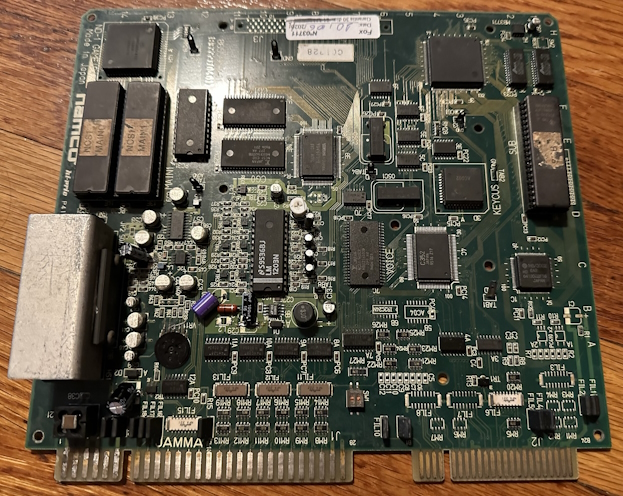-
A New Ongoing Project: The Satomi/Sammy/Three Star Arrangeball!
“Oh, what’d you get there? A new pachinko machine?” “It’s technically not a pachinko machine, though it does use pachinko balls, and a pachinko launcher…” “So it’s a new pachinko machine.” Such is the conversation between myself and my fiancee. What is this new machine? What have I gotten myself into? Is this the beginning of the analog age of Nicole Express? One thing’s for sure: it may be new to me, but it’s definitely not new.
-
The Namco ND-1: Taking 2D for Granted
Last year, I covered the CAVE CV-1000, an early-2000’s arcade platform that was the last gasp of dedicated 2D hardware, with a RISC CPU and a blitter. But that was to power fast-paced “bullet hell” shooters with huge numbers of moving objects each frame, where even slowdown is crucial to strategy. What if your aims were a bit more… pedestrian? What if all you wanted was to make some 80’s games on cheaper hardware?
-
The Parts-Bin Approach: Konami's Contra
Over and over, I look at games that are part of “systems”: the Sega System 1, the Hyper Neo Geo 64, the CAVE CV1000. But there ain’t no rule that says you have to organize your games that way. You could just take whatever parts are most convenient. The Panic Road board I built a pinball controller for is one example. But Konami is probably most associated with this approach. Let’s take Contra as a case study.
-
A Dangerous Hybrid: Speeding up the Super Game Boy
The Super Game Boy allows you to play Game Boy games on your Super Nintendo. This is an impressive feat, when you consider that the two consoles share basically nothing in common. Today, we’ll look at the hybrid machine that creates: a multi-processor machine where the two CPUs share nothing in common. And maybe, just maybe, we can make the Super Game Boy go fast.
-
Replacing the BIOS on the Book 8088
Imagine: a CGA laptop, in a modern form factor, but with a classic Intel 8088 (or even a NEC V20) inside. Throw in expansions for an ISA bus and an OPL3 sound card, and you’ve got a vintage computer afficionado’s dream, right? Well, for one thing: they stole the BIOS. Let’s fix that.
-
Bringing the Arcade Home, in 1984: The SG-1000 Arcade
The SG-1000. Somehow, we’re on the third blog post this year on this little white box. In part one, we RGB modded it, but then decided that it wasn’t good enough. In part two, we built a cartridge, and complained more about RGB. And now, we move on to something completely different: the SG-1000-based arcade hardware! But I don’t have one of those. If only there was something I could do about that… (Plus: a little more complaining about RGB)
-
Making Every Ball Count with a Pachinko Data Counter and... React?
So, you decided that after reading my post on hanemono, you had to get a modern pachinko machine for yourself. And now, after spending some time finding the sweet spot on the shooter and the perfect timing for the waving arms, you realize something: there’s no score. Even Pachi-Com has that! Well, the score in a gambling game is in your wallet (and will inevitably be negative). But if you’re playing for fun? What can be done then? And can you work Javascript into it?

